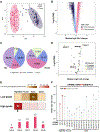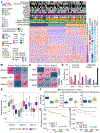Integrated glycoproteomic characterization of clear cell renal cell carcinoma
- PMID: 37074911
- PMCID: PMC10247542
- DOI: 10.1016/j.celrep.2023.112409
Integrated glycoproteomic characterization of clear cell renal cell carcinoma
Abstract
Clear cell renal cell carcinoma (ccRCC), a common form of RCC, is responsible for the high mortality rate of kidney cancer. Dysregulations of glycoproteins have been shown to associate with ccRCC. However, the molecular mechanism has not been well characterized. Here, a comprehensive glycoproteomic analysis is conducted using 103 tumors and 80 paired normal adjacent tissues. Altered glycosylation enzymes and corresponding protein glycosylation are observed, while two of the major ccRCC mutations, BAP1 and PBRM1, show distinct glycosylation profiles. Additionally, inter-tumor heterogeneity and cross-correlation between glycosylation and phosphorylation are observed. The relation of glycoproteomic features to genomic, transcriptomic, proteomic, and phosphoproteomic changes shows the role of glycosylation in ccRCC development with potential for therapeutic interventions. This study reports a large-scale tandem mass tag (TMT)-based quantitative glycoproteomic analysis of ccRCC that can serve as a valuable resource for the community.
Keywords: CP: Cancer; N-linked glycosylation; clear cell renal cell carcinoma; cross-correlation; glycoproteomics; mass spectrometry.
Copyright © 2023 The Authors. Published by Elsevier Inc. All rights reserved.
Conflict of interest statement
Declaration of interests The authors declare no competing interests.
Figures




References
-
- Li QK, Pavlovich CP, Zhang H, Kinsinger CR, and Chan DW (2019). Challenges and opportunities in the proteomic characterization of clear cell renal cell carcinoma (ccRCC): A critical step towards the personalized care of renal cancers. Semin Cancer Biol 55, 8–15. 10.1016/j.semcancer.2018.06.004. - DOI - PMC - PubMed
Publication types
MeSH terms
Grants and funding
LinkOut - more resources
Full Text Sources
Medical
Molecular Biology Databases
Miscellaneous

